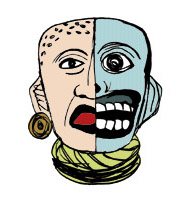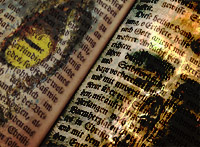Time-travel as a Premise
Writing time-travel tends to appeal to two different sorts of authors: hard science fiction writers [like Asimov] interested in the science of time-travel; and cultural science-fiction writers [such as Paul Anderson] who view time-travel as an opportunity to get creative with history and society. I am one of the later.
Upon deciding to go the time-travel route I made three decisions: to be committed to authentic character development; to examine the various theories about time-travel through the lives of these characters; and to treat time-travel as a form of exploration, rather than as a science experiment or as an excuse to write about my favorite time-periods.
Personally, what interests me the most about the subject of time-travel is the possibility of experiencing our world as a person from another timeframe. Most time-travel fiction focuses on a contemporary character’s attempts to interact with the past or future. I wanted to do what I could to turn this on its head. I hope I have managed to achieve a balance.
Time-travel as exploration is intriguing to me. Usually the only effect experienced by time-travelers in fiction is that they end up in a different time. This makes no sense. Let’s use two types of extreme exploration as models: exploration in the Age of Sail; and the Space Age. It is obvious from a reading on either of these subjects that the most hazardous aspect of cutting edge exploration is the mode of exploration itself. Scurvy, shipwreck and shipboard accidents among sailors were so deadly that even at the peak of this technology, the British Navy only suffered 8% of its casualties due to combat! Space travel is even more hazardous. In my mind, time-travel should pose intrinsic hazards for the explorer as well.
Another aspect of exploration is politics. As soon as folks find something they tend to start fussing over it. I decided to use the decentralized Age of Sail as a model instead of the more centralized Space Age model basically because that is a field I have read deeply in. Also, privatized, secretive and consensus-based time-travel organizations [this will definitely be an organized activity] leaves a lot more room for interesting character development compared to a more centralized effort to field teams of the ‘best and brightest’.
Time-travel Theories
The Grandfather Paradox, Time-branching, the Butterfly Effect, Racial Memory, Transmigration, Reincarnation, Ascension and Great Men verses the Weight of the World are all endlessly fascinating concepts that have been deeply pondered and puzzled over by more adept scientific thinkers than myself. I have chosen to address these concepts from the point-of-view of the protagonists in an adventure novel. I do not pick and choose which ‘law’ of time-travel I shall abide by, but have instead given each theory its due in at least one story.
The key for making this meaningful to me, as an author, is the exploration of such concepts from the strictly limited point-of-view of a vested protagonist. As a nonfiction writer I favor oral history and the memoir. As a novelist I prefer the view-point narrative.
The View-point Narrative
I stole this method from one of my favorite authors, George R. R. Martin, author of Game of Thrones. I have done my best to develop the use of this type of narrative. Basically it comes down to a commitment to limit the reader’s perspective to that of the character. The specific technique I borrowed from Martin was the use of italics to denote what is going through the character’s head. For this to work smoothly each chapter is best limited to a single character’s perspective.
This reveals itself as a demanding writing method once the author realizes that in order to present the reader with a sufficiently varied and nuanced story he must employ a character rotation. This can be psychologically demanding to the point of exhaustion. I might finish writing Chapter 3 from Three-Rivers’ perspective as a handicapped, celibate, vegetarian language savant, and then have to dive into the Jay Bracken Zone in Chapter 4 and depict life from the perspective of a cannibalistic war-machine who’s only intelligent arguments are those which he has with his own penis, the insubordinate Private Johnson. I’m on Book 4 and Jay has yet to win an argument with that single-mindedly mutinous organ.
The question I am most often asked about writing fiction is, “How do you come up with the characters?” That is a complex question that I will answer in a subdivided fashion. I use four specific methods of character creation. They are listed below from most to least common.
The Composite Character
Three-Rivers is the primary protagonist of the Sunset Saga. He is based on the Iroquois prophet Degenawida. I fleshed him out by giving him the handicaps of four people I have known. The science-fiction element of Three-Rivers is his language ability—he is a savant. If he hears it he never forgets it and can infer context definitions with high reliability. However his dependence on this ability results in some comic cross-cultural misunderstandings.
I get into Three-Rivers perspective by two methods: remembering how I viewed the world before puberty; and thinking back to those times as an adult when I was the most sensitive person in a given situation.
Three-Rivers looks like the little Asian American kid who won a 2010 Japanese trading card World Championships, and got to play cards in a televised match in Tokyo. I remember looking at this kid at a card tournament where I headed security and thinking, 'I bet this kid would love having some big hairy mass-murdering barbarian for a best friend.'
The story is ultimately about Three-Rivers. But Three-Rivers is an introspective character. To move the plot I knew early on that I needed an action hero in the tragic ancient sense; just like the kid at the tournament needed an escort to his mom’s car so he wouldn’t get jacked for his backpack full of expensive cards.
Jay Bracken is the major co-protagonist. I originally conceived of Jay as a ‘white-trash Conan’. He is an elemental character whose function from a writing perspective is as a plot- driver. He gets fragile characters like Three-Rivers and Charlie Robinson from A to Z without them being eaten by Q. This oddball action hero is based on psychopathic Indian fighter Lewis Wetzel. His sex appeal, name, likable nature and athletic ability are courtesy of Dante, a fighter I trained, who once knocked out all of the other men in a crowded bar over a hot chick—who he went home with, had hot sex with, sex that ultimately devolved like molten lava into a rocky relationship, which led him to a biker rally...
Jay, for some reason, looks like 20th Century actor Yule Brenner with body hair.
I get into Jay’s perspective very easily, because I can still clearly remember my own thought process and worldview from when I was a teen-ager. Although Jay Bracken is in his 30s through most of the series, he never mentally progresses beyond late adolescence. If I let him grow up I’d have to rename him.
The Historic Character
Most of the supporting characters are based on historical characters and fleshed out with people I have known or interviewed. A good example is the shadowy character of Bruco, based on a real Canary Islander, who is little more than a name in a history book. I decided to give Bruco [a stick-fighter] my [stick-fighting] friend Adam’s sense of humor. This is the general method, find an interesting and little known historical figure and then match them with a person with similar characteristics or socio-economic level, etc., to flesh them out.
Richard Burton is the lead protagonist in The World is Our Widow, Of Men with Bloody Hands and Three Thrones Gone. He is the single most interesting person I have read about. He has been done in sci-fi by Phillip Joseph Farmer in the River World novels. I like Farmer’s Burton and I want mine to be better, so I put a lot of research and thought into Burton. When I do Burton I try to think like a biographer, and then try to get inside of his head. This is not easy, and I must ultimately fail to see the world precisely as Burton did.
With a historic character like Burton it is helpful to discuss him with others. If you ask any modern person who Richard Burton was they will say, “The actor that was married to Elizabeth Taylor.”
I eventually—out of a very Burton impatience with the lack of well-read people around me—responded hostilely, “No, the real Richard Burton; who spoke twenty-nine languages, explored five continents, fought duels and wrote 35 books by hand while drinking opium-wine by lantern light in assorted tropical hell-holes!”
Imagine—having been sought out by time-travelers and brought forward to the 21st Century—Burton’s ire, when even history buffs mistake him for a drunken actor famous only for bedding a violet-eyed actress?
The Fabricated Character
Pendleton Shaw is a character I made up because I was in need of a witness to the culmination of three-days of intense savagery for the novel Thunder-Boy…
If you have read any of the Sunset novels then the picture of Jay Bracken pursuing some poor beaten bastard across a wasteland in his endless quest to enlarge his scalp collection is a familiar scene, usually played out stark and lonely. For once, at the end of Chapter 23 Warpath I wanted to give Jay an audience, so one of his war-crimes might live on as a story told around a campfire rather than just another sorrow buried in his hopelessly ravaged psyche.
I thought, 'Who could be a better amazed witness to the hapless slaughter of a doomed soul than a stuffy English aristocrat? Why one that is still a brat! Forget Neville Chamberlain decrying the barbarity of it all when you can have some rich kid in a wig cheering the killer on!'
Maybe it was the Jay in me. But after that scene, I just had to write Pendleton again, so he gets his own novel—and his 57% chance of dying horribly—in Seven Moons Deep.
The Patterned Character
Daniel London and Jan Stevenson are patterned on real people; or at least my versions of people who I know, and who I think could actually intelligently survive an adventure in a manly fashion. These men are martial artists and scholars, the kind of guys you might recruit to go back in time and talk to Burton or Archimedes.
My rule with patterned characters is that they won’t be killed. My fiction is a lethal environment, with—as Jan’s non-fiction inspiration pointed out—the time-travelers suffering 57% casualties. The advantage to using a patterned character is that you could actually ask your friend, “Hey, what would you ask Aristotle?” or “Would you fight the bear or jump off the cliff?”
It is important to use someone whose thought process you understand. As an author, I also take requests. I think Jan will really like the Italian Don’s widow in Buenos Aires in 1868…
The Scene-based Story
The Dewey Beach Event is the largest portion of Of The Sunset World, and could have been a novel. The story consists of 38 chapters written without a plot or outline. The story was based on four scenes that came to me over the course of a month or so during the winter of 2010. These scenes were titled: Beautiful Autumn Hill, Big Water Blood Song, The Greater Demon of Sunset and Meadow Hawk’s Battle.
Once these scenes were set in my mind I used a map and linked those 4 ‘cross-roads chapters’ with 34 lesser chapter titles. These lesser chapters were not outlined or drafted, and had no synopsis. I wrote them when the characters got there and role-played the characters, letting them follow their nature. This resulted in the deaths of some real major characters early on, which really sucked!
The result was that I had to rethink the final scene and write it to fit the surviving antagonists, as the projected hero and villain had both already been killed. I think it was a blessing in disguise. Honestly, the characters know each other better than I do, so I just let them decide now. I just hope I can write my way out of whatever hole they put me in. I think of this story-development method as writing from behind the characters.
As a final note, I usually adjust the table of contents when I’m about 30% through the story, sometimes demoting chapters to sub-chapters, which I like using. When I begin a chapter I write [usually 3-5] subchapter titles [essentially story hints] and then write the first draft. I proofread that draft 7 to 8 times on the computer then print it out for a hardcopy proof. I then let it sit for a month and reread it on hard-copy and computer, and make the final corrections. It takes me about 2 hours to produce a publishable page of about 500 words.
The Series Sketch
I found that making a series sketch and then tweaking it in between the first few novels was very helpful. I did not finalize the series sketch until I began writing Book 4 of 7. I want the sketch to be available to readers since I have attempted to write each novel as a stand-alone story, and would like readers to be able to start anywhere and enjoy it in context.











